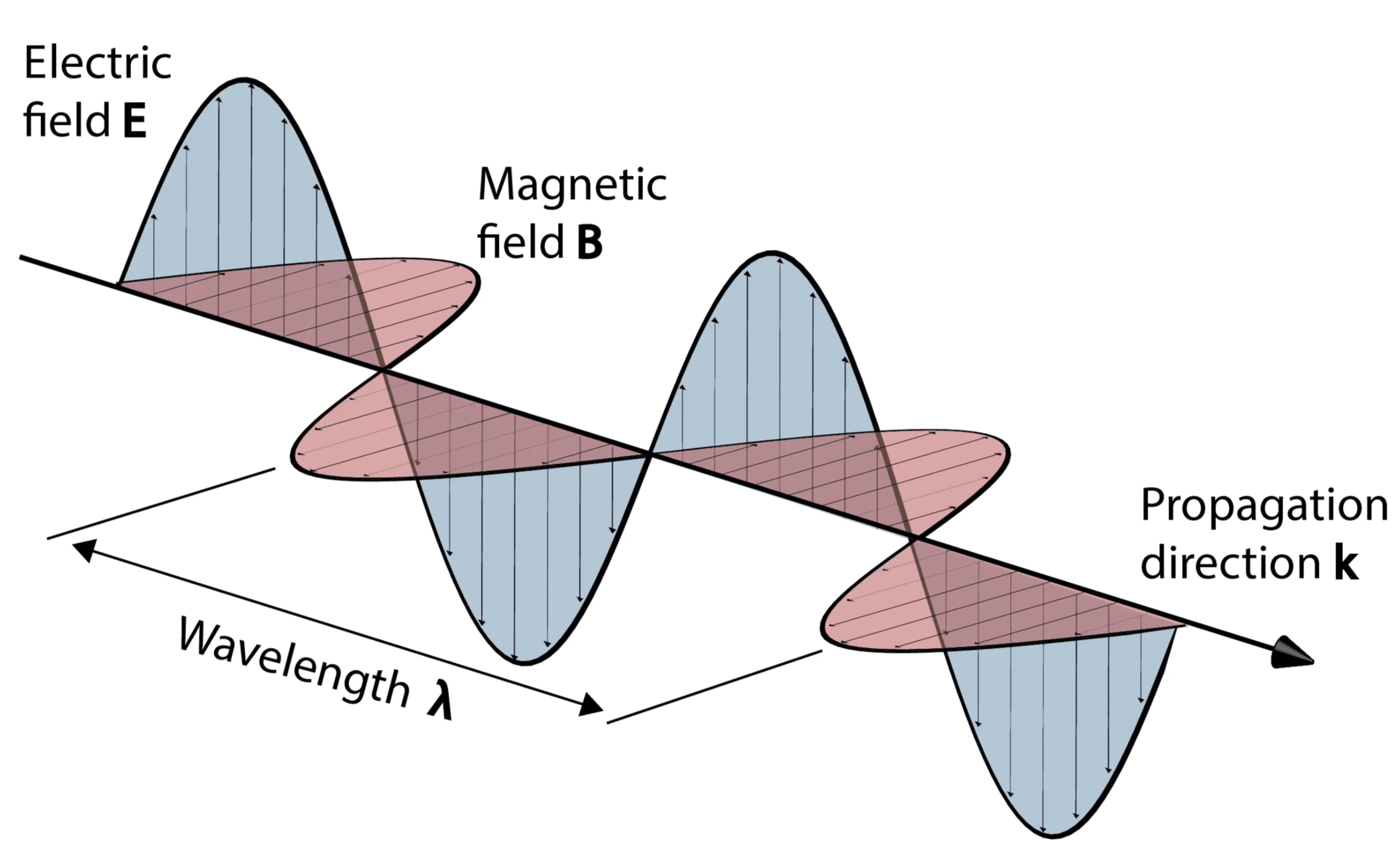Jump back to chapter selection.
Table of Contents
1.1 Microscopic Form of Maxwell's Equations in Vacuum
1.2 Maxwell's Equations in a Medium
1.3 The Material Equations
1.4 Macroscopic Approximation
1.5 Wave Equation
1.6 Solutions to the wave equation
1.7 Polarisation
1.8 Poynting Vector and Poynting's Theorem
1.9 Timescales
1.10 Momentum of Light
1 Electromagnetic Theory of Light
Light is an electromagnetic wave governed by the same theoretical principles that describe all forms of electromagnetic radiation. It consists of coupled oscillating electric and magnetic fields.
1.1 Microscopic Form of Maxwell's Equations in Vacuum
We begin with the simplest case by considering the electric and magnetic fields in free space, meaning there are no charges or currents present. The governing equations are Maxwell's equations:
Here,
A key property of Maxwell's equations is their linearity: any linear combination of solutions remains a valid solution. This has important implications, as we will see later. These equations have been experimentally confirmed for over a century and are fundamental to classical electrodynamics.
1.2 Maxwell's Equations in a Medium
To describe electromagnetic waves in a medium, we need a framework that accounts for the charge densities and currents at the atomic scale. The microscopic form of Maxwell's equations in a medium is given by:
where
- Gauss' Law: The electric field originates from charges. Positive charges act as sources, and negative charges act as sinks. The flux of
through a closed surface is proportional to the enclosed charge. - Gauss' Law for Magnetism: There are no magnetic monopoles; magnetic field lines always form closed loops. This distinguishes magnetic fields from electric fields, which can have isolated point sources (charges).
- Faraday's Law of Induction: A time-dependent magnetic field creates a circulating electric field. This principle underlies electromagnetic induction, which is the basis of electrical generators, transformers, and inductors.
- Ampère-Maxwell Law: Magnetic fields are produced both by electric currents and by changing electric fields. The latter term,
, is known as the displacement current density and allows electromagnetic waves to propagate even in the absence of actual charge flow.
While these equations describe the fundamental behaviour of electric and magnetic fields, solving them exactly in a material by tracking every individual charge is impractical. Instead, we often work with macroscopic versions of Maxwell’s equations. To achieve this, we introduce two auxiliary fields: the electric displacement field
The macroscopic fields are defined as:
where
In this course, we will be mainly concerned with isotropic media, meaning that the material response is independent of direction. This implies that the dielectric function
1.3 The Material Equations
Solving Maxwell's equations in a medium requires explicit relationships, known as material or constitutive equations, which describe how the medium responds to the fields. As mentioned earlier, these relationships depend on the material properties. To establish the macroscopic Maxwell's equations, we begin by separating both the total charge density
Free charges and currents are typically those that can move over macroscopic distances (like conduction electrons in a metal), while bound charges and currents are associated with localised atomic or molecular dipoles.
Our goal is to reformulate Maxwell's equations so that only free charges and currents appear explicitly as sources.
Starting from Gauss' Law in a medium,
By defining the polarisation density
we substitute this into Gauss' Law:
At this point, we have successfully removed explicit dependence on the bound charges.
A similar approach applies to the Ampère-Maxwell Law. The total current
Substituting this into the microscopic Ampère-Maxwell Law
Rearranging gives
Using the definitions of
We can summarise the microscopic Maxwell's equations (which are universally valid) and the macroscopic Maxwell's equations (useful for describing fields in media):
| Name | Microscopic Maxwell's equations (in medium) | Macroscopic Maxwell's equations |
|---|---|---|
| Gauss' Law | ||
| Gauss' Law for Magnetism | ||
| Faraday's Law of Induction | ||
| Ampère-Maxwell Law |
Additionally, the auxiliary relations defining
And the definitions relating bound sources to
1.4 Macroscopic Approximation
The macroscopic quantities
while the total current through a surface element associated with this volume is related to
The electric dipole moment of the volume
while the magnetic dipole moment is
The free charge and free current densities are then given by averages:
while the macroscopic polarisation and magnetisation are dipole moments per unit volume:
The macroscopic Maxwell equations effectively describe the fields averaged over these volumes. This approximation is valid as long as the fields do not vary significantly over the scale of the averaging volume.
To proceed further with solving problems, we require constitutive relations that link
- Electric and magnetic field dependence: It is often assumed that
depends primarily on and not on , while depends primarily on (or ) and not on . This is a good approximation for many materials at optical frequencies, although magneto-optic effects do exist where fields cross-couple. - Locality:
and are assumed to depend only on the fields and at the same position . This implies that the response is local and bound charges/currents do not move significantly relative to the scale over which the fields change. This is part of the long-wavelength approximation (wavelength much larger than atomic scales). Spatial dispersion occurs when this is not true. - Homogeneity: The functional dependence of
and on and respectively, does not vary with position in the medium, implying the medium is optically homogeneous. - Instantaneous Response (No Temporal Dispersion):
and at time are assumed to depend only on the values of and at the same time , eliminating time integrals (convolutions) in the time domain. This assumption is only valid for optically transparent materials far from any absorption resonances. In reality, this is often a poor approximation for many materials over a broad range of frequencies, and temporal dispersion (frequency dependence of material parameters like ) is crucial. This will be refined later. - Linearity:
and are assumed to be linear functions of and (or ), respectively. This is the domain of linear optics. Non-linear optics deals with higher-order dependencies. - Isotropy: The response of the medium is assumed to be independent of the direction of the applied fields. For isotropic media,
is parallel to , and is parallel to (or ). This means susceptibilities and permittivities can be treated as scalars. This assumption is violated in anisotropic materials like many crystals.
Let us examine the effect of these assumptions. With assumption 1, we may generally write the response as a functional of the field history. For instance:
With assumptions 2, 3, and 4 (locality, homogeneity, and instantaneous response), these simplify to:
With assumption 5 (linearity), we can expand
Here,
Finally, with assumption 6 (isotropy), the susceptibility tensors reduce to scalars multiplied by the identity tensor, so
The relative permittivity (dielectric constant)
Therefore, we can write the macroscopic constitutive relations as:
In optics, we generally deal with non-magnetic media, so
1.5 Wave Equation
To describe the propagation of light, we seek an equation that relates the temporal evolution of the fields to their spatial variation. We derive this for the case of a homogeneous, isotropic, linear, and non-magnetic (
Consider the macroscopic curl equation (Faraday's Law):
Apply the curl operator to both sides:
Using the vector identity
Since
Thus,
For the right side, we use the Ampère-Maxwell Law (macroscopic, no free currents):
Since
Substituting these into the curled Faraday's Law:
This yields the wave equation for
A similar derivation yields the wave equation for
Both equations have the form of a generic linear wave equation. The wave propagation speed, or phase velocity
The speed of light
The refractive index
This uses the assumption of a non-magnetic medium (
1.6 Solutions to the wave equation
One fundamental solution of the wave equation is the monochromatic plane wave:
where
The relation between the wavenumber
The wave equation is linear (since derivatives are linear operators), and thus any superposition of solutions is also a solution. While plane waves are simple solutions, they form a complete basis, meaning any solution to the wave equation can be expressed as a linear combination (or integral) of plane waves (Fourier decomposition).
From
For this to be zero at all times and positions, we require
Similarly for the magnetic field, a solution is:
The electric and magnetic fields of a plane wave are not independent. From Maxwell's equation
This implies that
The relationship between the amplitudes can also be expressed using the wave impedance of the medium,
Because the electric and magnetic fields are orthogonal to the direction of propagation, these waves are also called transverse electro-magnetic (TEM) waves.
It is often more convenient to use complex notation:
where
1.7 Polarisation
The polarisation of light describes the orientation of the electric field vector oscillation. For a plane wave propagating in the
Linear polarisation means that the electric field vector oscillates along a fixed straight line in the
where
The underlying physics of how materials respond to polarised light relates to how their constituent charges (and thus dipole moments) interact with the electric field. A microscopic electric dipole moment is
Polarisation is important in the interaction of light with matter: the amount of light reflected from or transmitted through a surface depends on it (Fresnel equations), as does the amount of light absorbed in many materials. This is even more general - light scattering is often polarisation dependent. The refractive index itself can be polarisation dependent in anisotropic materials.
Light does not have to be linearly polarised. The general case is elliptical polarisation, where the tip of the electric field vector traces an ellipse in the
This can be best shown graphically. In the following figures (source), a wave oscillates (red) into the
Linear polarisation - the total electric field vector oscillates along a straight line in the
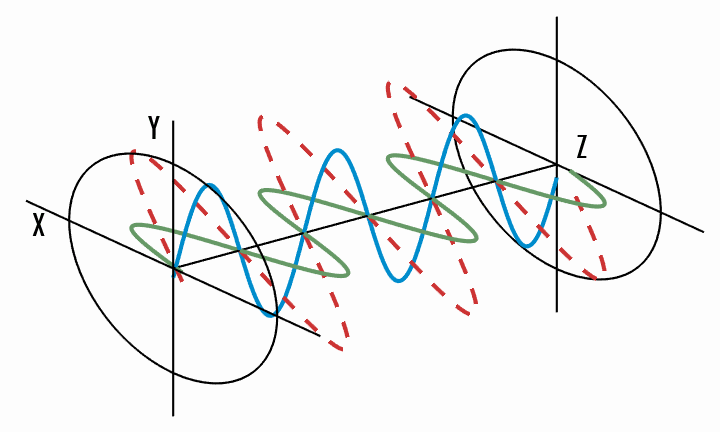
Elliptical polarisation - the total electric field vector traces an ellipse in the
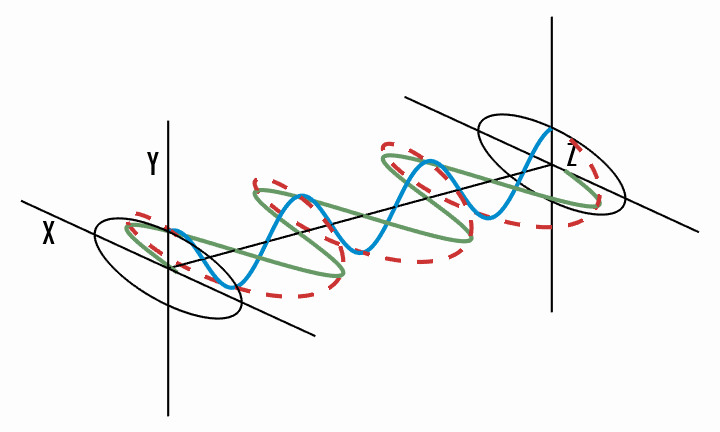
Circular polarisation - the total electric field vector traces a circle in the
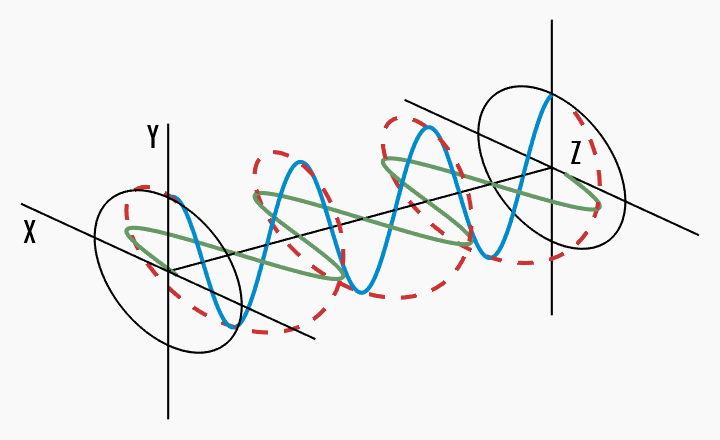
It becomes clear that circular polarisation is a special case of elliptical polarisation, where the
A linear polariser is an optical element that transmits light of a specific polarisation while blocking light of the orthogonal polarisation. If
If
1.8 Poynting Vector and Poynting's Theorem
Light carries energy. The quantity quantifying the rate and direction of electromagnetic energy flow per unit area is the Poynting vector
Its units are Watts per square metre (W/m
The Poynting theorem expresses energy conservation for electromagnetic fields. It states that the rate of decrease of electromagnetic energy stored within a volume, plus the rate of energy flowing out through the surface of that volume, equals the rate of work done by the fields on the free charges within the volume:
The electromagnetic energy density
The Poynting theorem represents the conservation or balance of energy: the power flow out of a volume plus the rate of increase of stored energy within that volume equals the negative of the power delivered to free charges (Ohmic losses if
To gain some intuition, the sign of the divergence of the Poynting vector indicates the local change in energy density due to flow:
- If
at a point, it means that energy is flowing away from that point (it acts as a source of energy flow if and are zero). - If
at a point, it means that energy is flowing into that point (it acts as a sink of energy flow if other terms are zero).
Proof of Poynting's Theorem:
We use real, instantaneous fields and currents. Start with Maxwell's curl equations (macroscopic form):
Take the dot product of (1) with
Take the dot product of (2) with
Subtract the second result from the first:
Using the vector identity
So,
For linear, non-dispersive media,
Similarly,
Thus, the term in parenthesis is
Substituting
which rearranges to the Poynting theorem:
Lastly, an animation to illustrate the electromagnetic wave and its Poynting vector in vacuum:

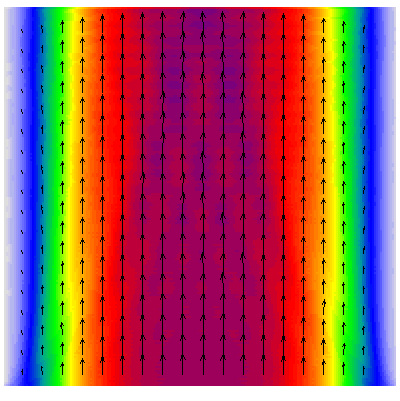
1.9 Timescales
If one optical cycle lasts roughly
The duration of one pulse is typically many optical cycles, while the duration of measurement can range from nanoseconds to milliseconds or longer. We can often separate the electric field into a slowly-varying envelope
This is depicted in the next figure. The overall pulse shape (left box-like behaviour in the example) is captured by the slowly-varying envelope
Let us next explicitly calculate the instantaneous Poynting vector for such fields. If we define the complex envelopes
The first term is slowly varying, while the second term oscillates rapidly at
To obtain a measure for the average energy flux over a measurement time interval
If
For stationary, monochromatic fields, the complex amplitudes
This time-averaged Poynting vector is often used to define the optical intensity
The intensity is therefore the magnitude of the time-averaged Poynting vector, and its units are typically Watts per square metre (W/m
1.10 Momentum of Light
Light carries not only energy but also momentum. The momentum density of an electromagnetic field in a medium with refractive index
When light is absorbed or reflected by an object, it exerts a force (radiation pressure) due to the transfer of momentum.
The momentum
For a light beam with time-averaged Poynting vector
If the surface is inclined such that its normal makes an angle
where
The linear momentum of light finds applications such as in laser cooling and trapping of atoms, optical tweezers, and proposals for light sails for spacecraft. The force exerted is the radiation pressure. For example, for a high-power ultrafast laser with pulse duration
